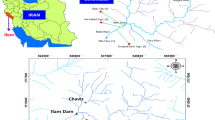Abstract
Reservoir is an efficient way for flood control and improving all sectors related to water resources in the integrated water resources management. Moreover, multiobjective reservoir plays a significant role in the development of a country’s economy especially in developing countries. All multi-objective reservoirs have conflicts and disputes in flood control and water use, which makes the operator a great challenge in the decision of reservoir operation. For improved multi-objective reservoir operation, an integrated modeling system has been developed by incorporating a global optimization system (SCE-UA) into a distributed biosphere hydrological model (WEB-DHM) coupled with the reservoir routing module. The new integrated modeling system has been tested in the Da River subbasin of the Red River and showed the capability of reproducing observed reservoir inflows and optimizing the multi-objective reservoir operation. First, the WEB-DHM was calibrated for the inflows to the Hoa Binh Reservoir in the Da River. Second, the WEB-DHM coupled with the reservoir routing module was tested by simulating the reservoir water level, when using the observed dam outflows as the reservoir release. Third, the new integrated modeling system was evaluated by optimizing the operation rule of the Hoa Binh Reservoir from 1 June to 28 July 2006, which covered the annual largest flood peak. By using the optimal rule for the reservoir operation, the annual largest flood peak at downstream control point (Ben Ngoc station) was successfully reduced (by about 2.4 m for water level and 2500 m3·s−1 for discharge); while after the simulation periods, the reservoir water level was increased by about 20 m that could supply future water use.
Similar content being viewed by others
References
IPCC. Climate Change 2007: Climate Chagne Impacts, Adapation and Vulnerability, Summary for Policy Makers. 2007
Oliveira R, Loucks D P. Operating rules for multireservoir systems. Water Resources Research, 1997, 33(4): 839–852
Ngo L L, Madsen H, Rosbjerg D. Simulation and optimisation modelling approach for operation of the Hoa Binh reservoir, Vietnam. Journal of Hydrology, 2007, 366(3–4): 269–281
Duan Q, Sorrooshian S, Gupta V K. Effective and efficient global optimization for conceptual rainfall-runoff models. Water Resources Research, 1992, 28(4): 1015–1031
Wang L, Koike T, Yang K, Jackson T J, Bindlish R, Yang D. Development of a distributed biosphere hydrological model and its evaluation with the Southern Great Plains Experiments (SGP97 and SGP99). Journal of Geophysical Research, 2009, 114: D08107, doi: 10.1029/2008JD010800
Wang L, Koike T, Yang K, Yeh P J F. Assessment of a distributed biosphere hydrological model against streamflow and MODIS land surface temperature in the upper Tone River Basin. Journal of Hydrology, 2009, 377(1–2): 21–34
Yang D, Koike T, Tanizawa H. Application of a distributed hydrological model and weather radar observations for flood management in the upper Tone River of Japan. Hydrological Processes, 2004, 18(16): 3119–3132
Saavedra O, Koike T, Yang D. Application of a distributed hydrological model coupled with dam operation for flood control purposes. Annual Journal of Hydraulic Engineering, JSCE, 2006, 50: 61–66
Burke E K, Landa Silva J D. The influence of the fitness evaluation method on the performance of multiobjective search algorithms. European Journal of Operational Research, 2006, 169(3): 875–897
Khu S T, Madsen H. Multiobjective calibration with Pareto preference ordering: An application to rainfall-runoff model calibration. Water Resources Research, 2005, 41: W03004, doi: 10.1029/2004WR003041
Tinh D Q. Participatory planning and management for flood mitigation and preparedness and trends in the Red River Basin, Vietnam. http://www.unescap.org/esd/water/disaster/2001/vietnam.doc, 2001
FAO. Digital Soil Map of the World and Derived Soil Properties, Land and Water Digital Media Series Rev. 1. Rome: Food and Agriculture Organization of United Nations, CD-ROM, 2003
van Genuchten M T. A closed form equation for predicting the hydraulic conductivity of unsaturated soils. Soil Science Society of America Journal, 1980, 44: 892–898
Onogi K, Tslttsui J, Koide H, Sakamoto M, Kobayashi S, Hatsushika H, Matsumoto T, Yamazaki N, Kaalhori H, Takahashi K. The JRA-25 reanalysis. Journal of the Meteorological Society of Japan, 2007, 85(3): 369–432
Myneni R B, Nemani R R, Running S W. Algorithm for the estimation of global land cover, LAI and FPAR based on radiative transfer models. IEEE Transactions on Geoscience and Remote Sensing, 1997, 35: 1380–1393
Nash J E, Sutcliffe J V. River flow forecasting through conceptual models part I-A discussion of principles. Journal of Hydrology, 1970, 10(3): 282–290
Author information
Authors and Affiliations
Corresponding author
Rights and permissions
About this article
Cite this article
Wang, L., Nyunt, C.T., Koike, T. et al. Development of an integrated modeling system for improved multi-objective reservoir operation. Front. Archit. Civ. Eng. China 4, 47–55 (2010). https://doi.org/10.1007/s11709-010-0001-x
Received:
Accepted:
Published:
Issue Date:
DOI: https://doi.org/10.1007/s11709-010-0001-x




